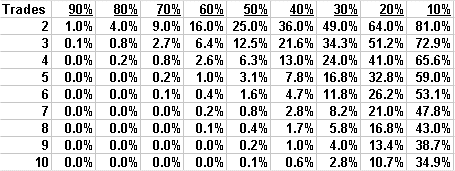Most traders put their emphasis on determining the best entry and exit points, but smart traders also consider how their money management rules will affect their performance.
Money management is probably the most overlooked area in trading and investing. Here are some questions to answer as you determine the most effective money management plan:
1. How much capital will you need to invest effectively? In today's markets, you should have at least $10,000, and preferably $20,000 or more in risk capital to trade. If you try to trade with less capital, the economies of scale diminish. For example if you traded once per day at $20 round trip in commissions, that's $5,000 in 250 trading days, or one year; so right away a $10,000 account needs to make 50% to cover these fees, while a $100,000 account needs to make just 5% to cover these commission costs. You should also factor in any other costs you incur to trade, such as quote vendors, trading software and computers, if dedicated. You can see that the more you invest on the front end, the bigger your account should be to make back these costs more easily.
2. What percentage of your capital will you invest in each trade? The amount of capital I typically use is 10% per trade in my own accounts. I know traders who commit anywhere from 5% of their account per trade to 20% of their account per trade. But the bottom line is what you are truly willing to RISK of the amount you invest. If I invest 10% of my equity for an options program, I only want to take a 20% loss as I seek not to risk more than 2% of my total account equity on any losing positions. I generally prefer not risking more than 1% of my total account equity on a losing trade, which would require a maximum 10% loss when investing 10% of my capital in a new trade.
The Kelly formula shows another way to determine the optimal percentage of capital to risk per trade:
The formula is: Kelly % = W - (1-W) / V
W = Winning Percentage
(1-W) = Losing Percentage
V = Average Winning Trade / Average Losing Trade
If W = 60%
If average winning trade = 500
If average losing trade = 250
Then Kelly % would = 40%
The Kelly formula suffers from a drawback in that it assumes all profits and losses are equal, which is not the case. However, it can help a trader get an approximate assessment of the percentage to invest once you know your system's winning percentage and the size of its average winner and average loser.
3. Are you at risk of committing too much to each trade? Most traders tend to overcommit their capital allocation per trade, and then go through an inevitable drawdown which knocks both their financial capital and takes their emotional capital out of the game. Look at the table below showing the odds of a string of losers over 100 trades. If you have a 50% winning percentage, odds are that you will see two losers in a row 25% of the time. If you are committing 20% of your capital per trade in an options portfolio with no risk control, you could experience a 60% drawdown in your capital which would likely knock you out of the game. Low winning percentage systems are not necessarily bad, especially when the size of the average winner is many times greater than the size of the average loser. But some traders may not be psychologically equipped to ride out the higher volatility that can come with a lower winning percentage. The best way to address this is start out more conservatively than you think you need to until you get comfortable with a method's upside and downside (general rule of thumb: cut your normal allocation per trade by half when you first get started).
Odds of a Losing Streak Over 100 Trades (Column Shows Win Percentage)

4. How many positions will you focus on at one time? I recommend you trade only a handful of stocks at any one time. I like to concentrate my portfolio in my best ideas, plus I like to stay focused on how each stock is acting. If my portfolio is too big (I'd say more than 10 stocks is too many to focus on, and I prefer to keep my open positions at 7 or less per dedicated portfolio), then I will lose focus and invariably miss an exit on a trade that I should have previously exited. When looking for new opportunities, I use computers to boil down thousands of stocks to ultimately the top three stocks or options I want to add to my portfolio at pre-defined levels on any given day. If my systems still leave me too many stocks and too many factors to look at, I will be unable to keep up with information overload. This will leave my mind overwhelmed, which will lead to an inability to pull the trigger, also known as "analysis paralysis." Famous analyst Richard Wyckoff suggested that look for signals that you might need a break from trading: "The first is a technical warning - the situation in which your analysis gives unclear, confused signals. The other two are emotional - relying on 'instinct' rather than research and a growing or chronic indecisiveness about executing trades." Stay focused on a small number of top-performing stocks as an antidote to avoid burn out from information overload.
Price Headley is the founder and chief analyst of BigTrends.com.